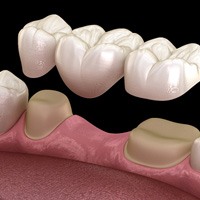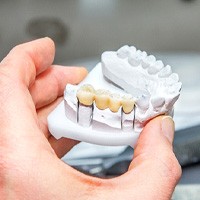Dental Bridges – Parker
An Affordable Solution to Tooth Loss
 Just one missing tooth can make a significant difference in your quality of life. Chewing, speaking, and smiling
without feeling self-conscious all become increasingly difficult. The good news is that if you are missing one or a
few consecutive teeth, a dental bridge could be exactly what you need to get your smile back. Read on to
learn more about dental bridges and how they work. If you think a dental bridge might be right for you, don’t
hesitate to give us a call to schedule a consultation.
Just one missing tooth can make a significant difference in your quality of life. Chewing, speaking, and smiling
without feeling self-conscious all become increasingly difficult. The good news is that if you are missing one or a
few consecutive teeth, a dental bridge could be exactly what you need to get your smile back. Read on to
learn more about dental bridges and how they work. If you think a dental bridge might be right for you, don’t
hesitate to give us a call to schedule a consultation.
Why Choose Rodney L. Allen, DDS for Dental Bridges?
- Customized for Natural Appearance
- We Welcome Dental Insurance
- Flexible Financing Available

What Is a Dental Bridge?
A dental bridge works by filling in the gap left by missing teeth. Bridges can contain one or more replacement teeth, also called “pontics.” When combined with dental crowns, dental bridges provide a durable tooth replacement solution. The dental crowns are anchored onto the healthy adjacent teeth or dental implants, depending on the type of bridge you opt for. This restoration can be made from a variety of durable, natural-looking materials that blend in seamlessly with the rest of your smile.

Types of Dental Bridges
There are two different types of dental bridges that help to meet different needs. Here is how each one works:
Traditional Dental Bridge
For patients who have healthy teeth on either side of the gap, a traditional denture is usually ideal. The teeth that support the dental crowns are called “abutment teeth,” and they are altered slightly so the dental bridge fits comfortably in the mouth. This type of restoration is usually placed in two visits to the dental office and is more affordable than their implant counterparts.
Implant Bridge
If you don’t have healthy adjacent teeth, dental implants can be surgically inserted into the jawbone to act as an alternative option. Dental implants are typically used when there are three or more missing teeth in a row. Implant bridges are made to last longer than traditional bridges on average, and they prevent bone loss from occurring over time.

The Benefits of Getting a Dental Bridge
You can experience a variety of benefits by opting for a dental bridge to replace missing teeth. Here are some of the most prominent ones:
- Prevents dental drift
- Improved self-confidence
- Improves chewing ability
- Lowers risk of oral health issues
- Cost effective
- Improves speech articulation

